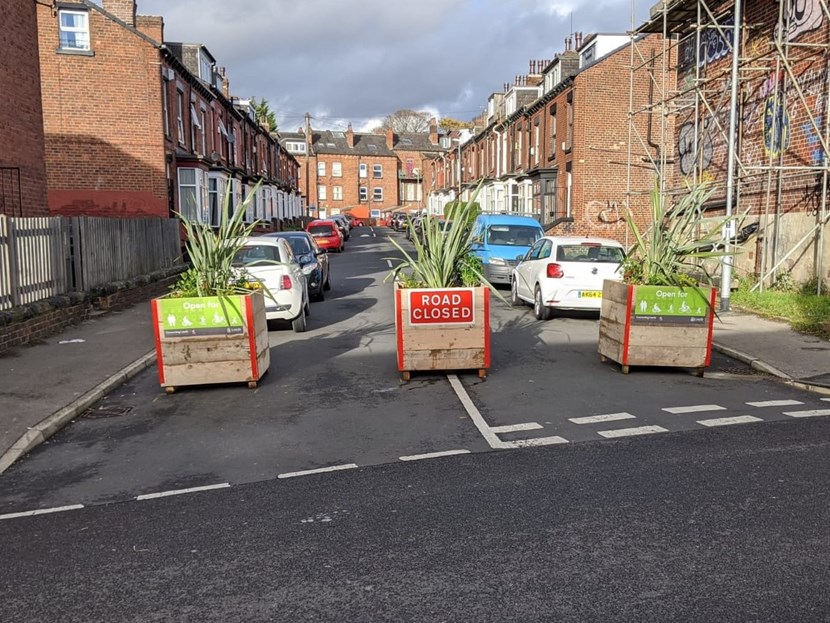
09 Nov 2020
First ‘Active Travel Neighbourhood’ pilots across Leeds
Leeds City Council has unveiled its first trial active travel neighbourhoods with a range of measures that have been designed to make these residential areas of the city much more child, pedestrian and cycle friendly.
This month will see active travel neighbourhoods (also known as ‘low traffic neighbourhoods’) introduced initially in Hyde Park and Chapeltown, with a scheme in Beeston soon to follow. It marks the start of temporary trials for a minimum of six months, during which the council will closely consult, monitor and evaluate their impact.
The council will use experimental traffic orders under the government’s emergency active travel measures to see if traffic levels reduce. The trial changes are looking to improve road safety, encourage children to play outside, promote walking and cycling and make the air in these residential streets cleaner to breathe. Local residents will be able to provide feedback throughout the trial and their responses will help to determine whether the schemes are amended, retained or withdrawn.
Active travel neighbourhoods are clusters of residential streets near to main roads that are enclosed to restrict through traffic. These measures are intended to discourage and deter rat-running through residential streets. Road layouts are changed using planters and signs, which provide the flexibility to re-locate in response to local needs, as the trial progresses. The council’s parks and countryside team will install up to 120 planters across 60 locations, over the first Active Travel Neighbourhoods. All streets can still be accessed by residents, businesses, deliveries and emergency vehicles but it will no longer be quicker for vehicles that do not need to visit the area to cut through. Car traffic will be directed to the surrounding distributor roads along the shortest possible route.
Since May, the council through Connecting Leeds has consulted and collected suggestions through the Commonplace platform, allowing residents to highlight issues in their local areas and ways to resolve them. Over 4,500 resident responses and 24,000 contributions found that excessive levels of traffic and speeding were the key concerns identified locally; residents also wanted to see more space for walking and cycling as well as more greenery.
The public consultation is underway and residents in each area can have their say on https://leedscovidresidentialstreets.commonplace.is/overview.
This work supports a wider programme of initiatives being carried out as part of the council’s response to Covid-19, taking emergency action to help people of all ages to walk and cycle safely as part of the council’s ‘safe streets, save lives’ campaign and further supporting greener, healthier, safer neighbourhoods for Leeds residents.
In June the Department for Transport allocated £730,000 to Leeds via the West Yorkshire Combined Authority, to fund these trial Active Travel Neighbourhood schemes, the fourteen school streets initiatives and two of the trial segregated cycle schemes introduced in the city over the last few months.
Councillor Lisa Mulherin, Leeds City Council’s executive member for climate change, transport and sustainable development, said
“I would to thank the thousands of people in Leeds who have already taken part in our online consultation to make the best use of the emergency active travel money the government has made available to us so far to make our streets safer for walking, wheeling and cycling.
“Our goal for active travel neighbourhoods is to make our residential areas safer and deter rat-running through them, creating local streets that are safer, greener and healthier for the people of all ages that live there to walk, wheel, cycle and play.
“These are trial schemes and we will be listening closely to local residents and their experiences, the positives and the negatives while they are in place. We will be monitoring the effects carefully and listening to residents feedback to determine the next steps for these schemes.
“We would normally have undertaken extensive local consultation before delivering anything like this on the ground, but the conditions of the government’s emergency active travel funding required councils across the country to submit, design and deliver schemes on the ground in a matter of weeks. We are seeking the views of local residents throughout the trial schemes in their neighbourhood based on their experience of them.
“I and local ward Councillors look forward to hearing your views and encourage people to participate in the consultation by visiting our commonplace website and support our efforts to have safe streets and save lives.”
-ENDS-
For media enquiries contact:
Charley Richardson
Leeds City Council
charley.richardson@leeds.gov.uk